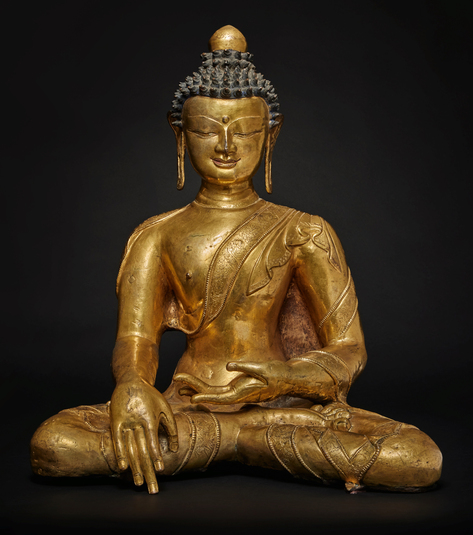
Item: Shakyamuni Buddha - Shakyamuni
| Origin Location | Central Tibet |
|---|---|
| Date Range | 1300 - 1399 |
| Lineages | Buddhist |
| Size | 54.60cm (21.50in) high |
| Material | Metal, Mercuric Gild |
| Collection | Private |
Classification: Person
Appearance: Buddha
Gender: Male
Shakyamuni Buddha (Tibetan: sha kya tu pa, sang gye. English: the Enlightened One, Sage of the Shakya Clan) together with Lama Tsongkapa above and protectors below.
Sanskrit: Buddha Shakyamuni Tibetan: Sang gye sha kya tu pa
Tibetan: Sang gye sha kya tu pa
Formal in appearance, Shakyamuni Buddha gazes forward with partially closed eyes. The blue-black hair on the head is piled in a tuft on top with a large ornament adorning the crown. Between the eyebrows is a plain dot representing the 'urna'. Adorning the neck are three horizontal lines. The earlobes are long and pierced. With the right arm bare the hand is extended across the knee in the earth touching gesture. The left hand performs the gesture of meditation, palm upward in the lap. Across the left shoulder is a robe incised with a floral pattern along with a similar lower garment. The legs are folded in vajra posture. The single or double lotus base is missing along with a possible square throne and torana.
"Born in the Shakya race through skillful means and compassion; destroying the army of Mara who was unable to be destroyed by others; with a body radiant like a mountain of gold. Homage to you, King of Shakya." (Sakya liturgical verse).
The term 'buddha' refers to the historical Shakyamuni Buddha along with the various buddhas mentioned in the Mahayana sutra texts. In Vajrayana Buddhism the term buddha can apply to any number of different types of deities that are enlightened. The meaning of buddha in Himalayan art is understood through the Three Definitions and the Six Topics.
Vajra Posture: seated with the left leg and foot, sole up, placed on the right thigh and the right leg and foot placed on the left thigh. In Indian Yoga systems this posture is called padmasana - 'lotus posture' - however in Buddhism this is known as vajrasana - or 'vajra posture.' Examples - All Buddha Forms (except for Maitreya in some cases), Amitayus, Vajradhara, Vajrasattva, Vajradharma, Chaturbhuja Lokeshvara, White Manjushri, Arapachana Manjushri, White Tara, Maitreya (bodhisattva form), Akshobhyavajra Guhyasamaja, Manjuvajra Guhyasamaja, Chintamani Lokeshvara, Eleven Faced Lokeshvara (Eight Fears), Chunda Tara, Ushnishavijaya, Prajnaparamita, Buddha Lochana, Arolik Lokeshvara, Blue-green Vajravidarana, Vishvamata, Grahamatraka.
Jeff Watt 1-2024
Buddhist Deity: Buddha (Characteristics & Attributes)
Shakyamuni Buddha: Main Page




